Themed collection Microfluidics Research 2015-2016

Single-cell analysis based on lab on a chip fluidic system
The combination of nano/microfabrication-based technologies with cell biology has laid the foundation for facilitating the spatiotemporal analysis of single cells under well-defined physiologically relevant conditions.

Anal. Methods, 2015,7, 8524-8533
https://doi.org/10.1039/C5AY02029H
Recent developments in electrochemical paper-based analytical devices
This mini-review discusses recent advances in electrochemical paper-based analytical devices with an emphasis on applications of traditional electrochemical methods.
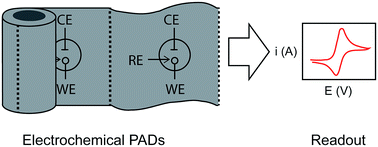
Anal. Methods, 2015,7, 7951-7960
https://doi.org/10.1039/C5AY01724F
Microfluidic protein crystallisation controlled using spontaneous emulsification
Microdroplet-based protein crystallisation using spontaneous emulsification is proposed and demonstrated. The dependency of crystal number in a single microdroplet on the surfactant concentration is discussed.
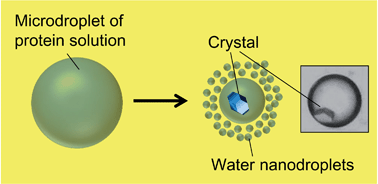
Anal. Methods, 2015,7, 7128-7131
https://doi.org/10.1039/C5AY00578G
A miniaturized chemiluminescence detection system for a microfluidic paper-based analytical device and its application to the determination of chromium(III)
A miniaturized detection system for chemiluminescence that is generated on a microfluidic paper-based analytical device (μPAD) was developed using optical fibers and was applied to the determination of Cr(III).
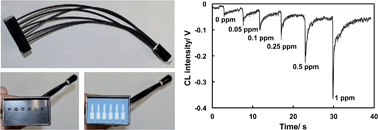
Anal. Methods, 2016,8, 5414-5420
https://doi.org/10.1039/C6AY00954A
Comparison of three indirect immunoassay formats on a common paper-based microfluidic device architecture
The ability to detect antibodies that are generated during an immune response is integral to the diagnosis and monitoring of infections.

Anal. Methods, 2016,8, 5204-5211
https://doi.org/10.1039/C6AY01558A
Integrated microfluidic aptasensor for mass spectrometric detection of vasopressin in human plasma ultrafiltrate
We present a microfluidic aptamer-based biosensor for detection of low-molecular-weight biomarkers in patient samples.
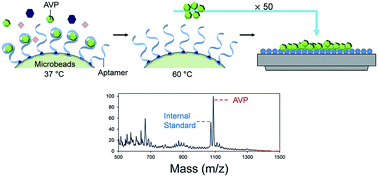
Anal. Methods, 2016,8, 5190-5196
https://doi.org/10.1039/C5AY02979A
Microfluidic flow-injection thermal-lens microscopy for high-throughput and sensitive analysis of sub-μL samples
A μFIA-TLM method is developed for high throughput (over ten samples per min) and sensitive analysis of sub-microliter nonfluorescent samples in flowing mediums.

Anal. Methods, 2016,8, 5053-5060
https://doi.org/10.1039/C6AY00932H
Real-time determination of carcinoembryonic antigen by using a contactless electrochemical immunosensor
A sensitive label-free and contactless impedance immunosensor is developed for the real-time interaction investigation between a cancer biomarker carcinoembryonic antigen (CEA) and its antibody CEA 5909. The immunosensor is proved to have a specific binding process between CEA and CEA 5909 with a detection limit of 100 fg mL−1 in PBS.

Anal. Methods, 2016,8, 4861-4866
https://doi.org/10.1039/C6AY00822D
Online monitoring of ethanol concentration using a responsive microfluidic membrane device
A novel method for online monitoring of ethanol concentration has been proposed by successfully developing an ethanol-responsive microfluidic membrane device.
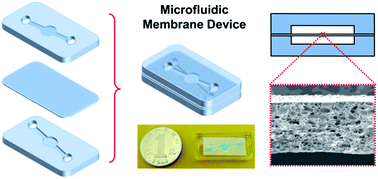
Anal. Methods, 2016,8, 4028-4036
https://doi.org/10.1039/C6AY00432F
Simplifying microfluidic separation devices towards field-detection of blood parasites
By the integration of multiple deterministic lateral displacement arrays of specific depths we present a simple-to-use diagnostics device, actuated by a simple syringe, aimed at point-of-care detection of blood parasites.
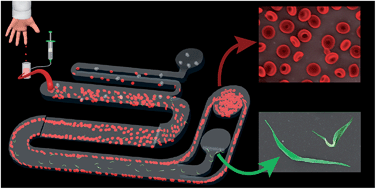
Anal. Methods, 2016,8, 3291-3300
https://doi.org/10.1039/C6AY00443A
Digital droplet LAMP as a microfluidic app on standard laboratory devices
Digital droplet LAMP is performed on a disposable chip (DropChip) with the size of a microscope slide using only standard laboratory devices.

Anal. Methods, 2016,8, 2750-2755
https://doi.org/10.1039/C6AY00600K
A BSA coated NOA81 PCR chip for gene amplification
We fabricated a NOA81 PCR chip (NP-chip) and first proposed a simple BSA coating method to successfully overcome the low PCR efficiency induced by the inhibition of the NP-chip which seriously impacted its application in the area of gene amplification.

Anal. Methods, 2016,8, 2584-2591
https://doi.org/10.1039/C5AY03233D
3D printing of microfluidic devices for paper-assisted direct spray ionization mass spectrometry
We describe the use of a RepRap 3D printer to fabricate microfluidic devices for direct spray ionization mass spectrometry assisted by paper tips.
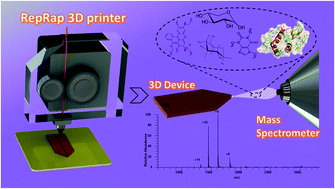
Anal. Methods, 2016,8, 496-503
https://doi.org/10.1039/C5AY03074A
Direct digital manufacturing of a mini-centrifuge-driven centrifugal microfluidic device and demonstration of a smartphone-based colorimetric enzyme-linked immunosorbent assay
This study reports the first demonstration of an enzyme-linked immunosorbent assay (ELISA) using a microfluidic device that was fabricated in a three-dimensional (3D) printer.
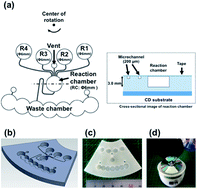
Anal. Methods, 2016,8, 256-262
https://doi.org/10.1039/C5AY01969A
An integrated sensing and wireless communications platform for sensing sodium in sweat
A wearable device for real-time monitoring of sodium levels in sweat is presented.
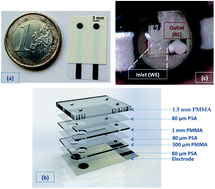
Anal. Methods, 2016,8, 64-71
https://doi.org/10.1039/C5AY02254A
Ionic electroactive polymer actuators as active microfluidic mixers
On-chip sample processing is integral to the continued development of lab-on-a-chip devices for various applications. We have demonstrated an active microfluidic mixer using ionic electroactive polymer actuators as artificial cilia.

Anal. Methods, 2015,7, 10217-10223
https://doi.org/10.1039/C5AY01061F
Geometrically controlled preparation of various cell aggregates by droplet-based microfluidics
We present a microfluidic droplet-based approach that can easily produce different shapes of cell aggregates in Ca-alginate microparticles by changing alginate and CaCl2 concentrations.

Anal. Methods, 2015,7, 10040-10051
https://doi.org/10.1039/C5AY02466H
Thread-based microfluidic three channel device in combination with thermal lens detection for the determination of copper and zinc
A new method involving a thread-based microfluidic three channel device in combination with thermal lens detection was developed for the sequential determination of Cu(II) and Zn(II).

Anal. Methods, 2015,7, 8757-8762
https://doi.org/10.1039/C5AY01458A
Non-motile sperm cell separation using a spiral channel
Inertial microfluidics are used to continuously separate non-motile sperm from blood and other contaminants.
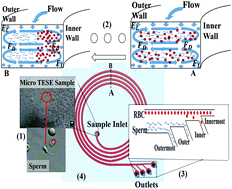
Anal. Methods, 2015,7, 8041-8047
https://doi.org/10.1039/C5AY02205C
The development of paper microfluidic devices for presumptive drug detection
Colorimetric detection of morphine on a 6 channel paper microfluidic device.

Anal. Methods, 2015,7, 8025-8033
https://doi.org/10.1039/C5AY01432H
Colorimetric determination of nitrite in clinical, food and environmental samples using microfluidic devices stamped in paper platforms
Paper microfluidic devices were explored to perform the colorimetric determination of nitrite in saliva, sausage, ham, preservative water and river water samples with no statistical difference from a reference method.
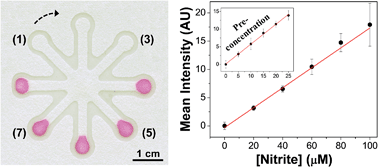
Anal. Methods, 2015,7, 7311-7317
https://doi.org/10.1039/C5AY00466G
Hydrodynamic nonadhesive cell retention in a microfluidic circuit for stressless suspension culture
Cell collection based on deterministic lateral displacement (DLD) and cell circulation with a loop channel are two component technologies for stressless cell retention which have been developed with a view to working toward suspension culture in a microfluidic channel.
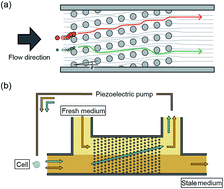
Anal. Methods, 2015,7, 7264-7269
https://doi.org/10.1039/C5AY00485C
A strategy for minimizing background signal in autoinductive signal amplification reactions for point-of-need assays
This paper describes a small molecule signal amplification reagent and an assay strategy that incorporates in situ signal amplification with minimal production of background signal.
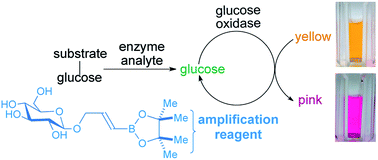
Anal. Methods, 2015,7, 7186-7192
https://doi.org/10.1039/C5AY00508F
Whole-cell based aptamer selection for selective capture of microorganisms using microfluidic devices
Selective capture of microorganisms is an effective and rapid technique for microbe detection.
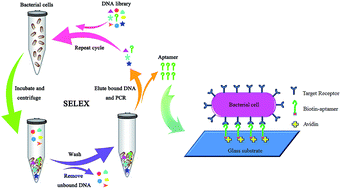
Anal. Methods, 2015,7, 6339-6345
https://doi.org/10.1039/C5AY01016K
A novel microfluidic device for selecting human sperm to increase the proportion of morphologically normal, motile sperm with uncompromised DNA integrity
We assessed a microfluidic method of sperm selection.
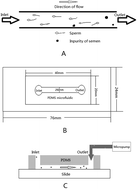
Anal. Methods, 2015,7, 5981-5988
https://doi.org/10.1039/C5AY00905G
Development of a low cost microfluidic sensor for the direct determination of nitrate using chromotropic acid in natural waters
This study has demonstrated, for the first time, a microfluidic autonomous analyser for the direct determination of nitrate, incorporating a modified version of the chromotropic method resulting in a direct, quick, inexpensive and simple procedure to measure nitrate in situ.

Anal. Methods, 2015,7, 5396-5405
https://doi.org/10.1039/C5AY01357G
Fabrication and characterization of all-polystyrene microfluidic devices with integrated electrodes and tubing
A new method of fabricating all-polystyrene devices with integrated electrodes and fluidic tubing is described.
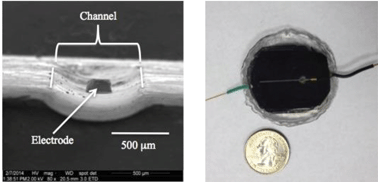
Anal. Methods, 2015,7, 2968-2976
https://doi.org/10.1039/C5AY00197H
Thermoelectric lab-on-a-chip ELISA
Thermoelectric lab-on-a-chip ELISA is a novel method performing immunoassays by measuring the heat of the enzymatic reaction between enzyme-linked detection antibody and a substrate using a thin-film thermopile.
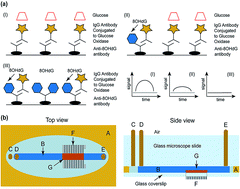
Anal. Methods, 2015,7, 2055-2063
https://doi.org/10.1039/C4AY02764G
Continuous flow microfluidic solution for quantitative analysis of active pharmaceutical ingredient content and kinetic release
Counterfeit and substandard medicines are a grave public health concern that comprises a multibillion-dollar black market and claims over 100 000 lives every year.
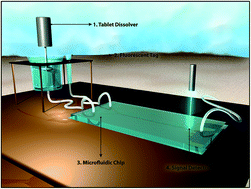
Anal. Methods, 2015,7, 1914-1923
https://doi.org/10.1039/C4AY02884H
A localized temporary negative pressure assisted microfluidic device for detecting keratin 19 in A549 lung carcinoma cells with digital PCR
Digital polymerase chain reaction (dPCR) has played a major role in biological research, especially by providing an accurate counting of single nucleic acid molecules.
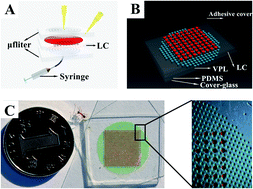
Anal. Methods, 2015,7, 2006-2011
https://doi.org/10.1039/C4AY02604G
A paperfluidic device for dental applications using a novel patterning technique
We have developed a fully printable paperfluidic chip for monitoring oral health.

Anal. Methods, 2015,7, 1293-1299
https://doi.org/10.1039/C4AY02802C
Concurrent DNA preconcentration and separation in bipolar electrode-based microfluidic device
A microfluidic device combining bipolar electrode phenomenon and end-labeled free-solution electrophoresis for concurrent preconcentration and separation of DNA samples.

Anal. Methods, 2015,7, 1273-1279
https://doi.org/10.1039/C4AY01858C
Integrated hybrid polystyrene–polydimethylsiloxane device for monitoring cellular release with microchip electrophoresis and electrochemical detection
In this work, a polystyrene (PS)–polydimethylsiloxane (PDMS) hybrid device was developed to enable the integration of cell culture with analysis by microchip electrophoresis and electrochemical detection.

Anal. Methods, 2015,7, 884-893
https://doi.org/10.1039/C4AY02569E
Rapid inoculation of single bacteria into parallel picoliter fermentation chambers
An injected air bubble serves as a reproducible mechanism to modify laminar flow conditions during single cell inoculation.

Anal. Methods, 2015,7, 91-98
https://doi.org/10.1039/C4AY02257B
Simultaneous colorimetric detection of improvised explosive compounds using microfluidic paper-based analytical devices (μPADs)
In this paper the development of microfluidic paper-based analytical devices (μPADs) is described for the rapid, on-site detection of improvised explosives.
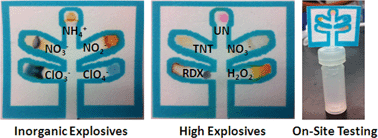
Anal. Methods, 2015,7, 63-70
https://doi.org/10.1039/C4AY01677G
Integrated electrodes and electrospray emitter for polymer microfluidic nanospray–MS interface
The goal of this work is to develop a stable nanospray chip–MS interface that contains easily integrated electrodes and an embedded capillary emitter to mitigate current chip–MS problems.
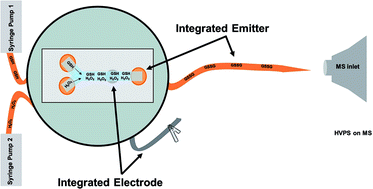
Anal. Methods, 2016,8, 5152-5157
https://doi.org/10.1039/C6AY00197A
Development of an automated on-chip bead-based ELISA platform
We present a lab-on-a-chip and associated instrument for heterogeneous enzyme-linked immunosorbent assay (ELISA)-based detection of proteins from liquid samples.

Anal. Methods, 2015,7, 8472-8477
https://doi.org/10.1039/C5AY00264H
Correction: Simplifying microfluidic separation devices towards field-detection of blood parasites
Anal. Methods, 2016,8, 5726-5726
https://doi.org/10.1039/C6AY90099B
Correction: The development of paper microfluidic devices for presumptive drug detection
Anal. Methods, 2015,7, 8977-8977
https://doi.org/10.1039/C5AY90077H
About this collection
To mark the 20th International Conference on Miniaturised Systems for Chemistry and Life Sciences, MicroTAS 2016, this collection highlights the high impact research published on microfluidics in Analytical Methods in 2015 and 2016.